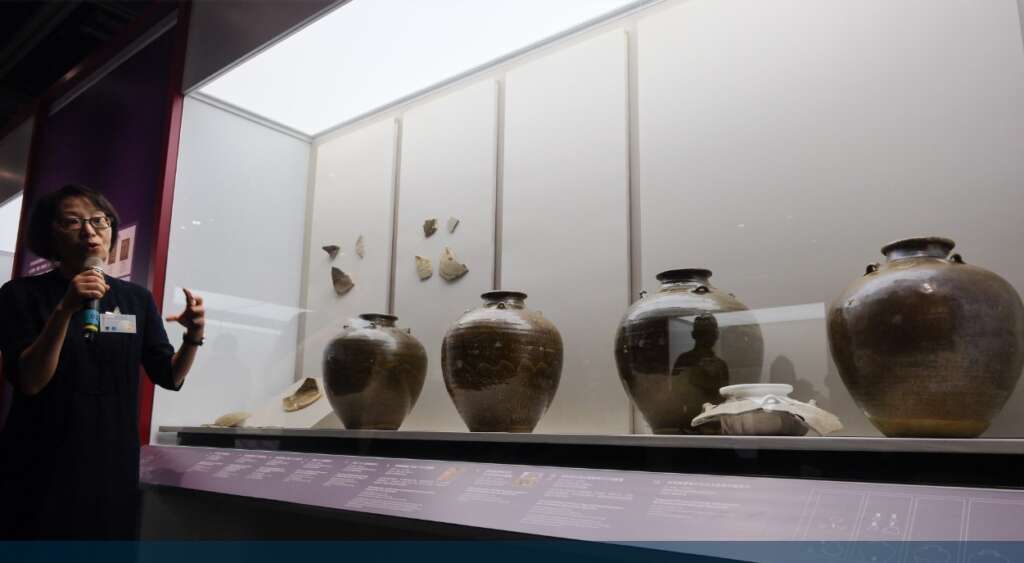Troves of invaluable relics and artefacts discovered from famous Song dynasty’s sunken vessel, Nanhai No.1 (南海一號), are on display in Hong Kong.
Traceable back to the period of Southern Song dynasty (AD1127-1279) about 800 years ago, the Nanhai No.1, which literally means South China Sea No.1, is one of the world’s oldest ocean-going merchant vessels. It is also one of the largest ancient Chinese ships ever found in the country.

The salvage of the Nanhai No.1 stunned the world when Chinese archaeologists and engineers had designed a tailored-made metal caisson to contain the vessel’s hull and lifted it deep from the seabed off the coast of Guangdong’s Yangjiang (陽江) in 2007.
For Hong Kong, it is the first time that so many – more than 250 – artefacts from the Nanhai No.1 are displayed in the city. Among those precious exhibits are porcelain items, gold ornaments and accessories, and silverware.
Over 180,000 relics have been excavated from the vessel, which include gold and silver items and copper coins.
The relics from the shipwreck showcase the prosperous maritime trading scene in the Song dynasty, and they are significant to the studies into the history of China’s bustling trade activities with countries in Southeast Asia, the Middle East and Europe along the Maritime Silk Road (海上絲綢之路).
Chinese archaeologists believe that the Nanhai No.1 might have sunk along the maritime route from Guangdong in the reign of Emperor Xiaozong (宋孝宗) in AD 1183 – which is the 10th year of the Chunxi period (淳熙十年) or shortly afterwards.

With the theme of “Launch from Greater Bay Area: Nanhai I Shipwreck and the Maritime Silk Road”, the exhibition is co-organized by China’s National Cultural Heritage Administration, Hong Kong’s Development Bureau and Macau’s Secretariat for Social Affairs and Culture.
The exhibition is held at the Heritage Discovery Centre in Tsim Sha Tsui’s Kowloon Park from now onwards to February next year.
PRECIOUS ARTEFACTS
In the exhibition, a necklace with gold chain and rhinoceros horn-shaped cone ornaments (金單頂鏈犀角形錐筒飾項鍊), and a gem-set hollow gold bracelet (鑲寶石空心金鐲) have been highlighted. There are also ancient gold rings and gold strip-shaped accessories on display.

Another renowned relic exhibited is a brown glazed jar with four lugs (四繫罐) with Chinese characters – the 10th year of the Chunxi reign (淳熙十年). The jar was manufactured from famous Nanhai kiln (南海窰).

Other exhibits are a glazed foliated bowl with stamped plum blossom pattern (青白釉印花枝梅紋花口碗) curated from the Jingdezhen kiln (景德鎮窰) in Jiangxi province, and a green glazed ogee-shaped foliated dish with incised lotus pattern (青釉刻劃蓮紋折腰花口碟) from the Longquan kiln (龍泉窰) in Zhejiang province.

HONG KONG’S ROLE
Hong Kong played a significant role in ancient China’s trading activities along the Maritime Silk Road in the Song and Ming dynasties.
In the period, Chinese silk, pottery, tea, and other goods were exported to Southeast Asia and Europe, whereas spices, woollen textiles, accessories and other commodities were brought into China from overseas.
Foreign commercial vessels heading to China usually replenished their supplies in Hong Kong before continuing up the Pearl River to Guangzhou. At the same time, Chinese commercial ships which exported goods to overseas countries also sailed through Hong Kong.
Hong Kong was a transition point along the Maritime Silk Road as the city was a safe harbour and an ideal port for Chinese traders to replenish supplies to embark on maritime trade journeys.
STRUCTURE WELL-PRESERVED
First discovered in 1987, the wooden Nanhai No.1 was found by a joint Sino-British salvage team, including officials from the Guangzhou Salvage Bureau. In the beginning, the team’s members were looking for the sunken Dutch East India Company vessel Rimsburge, but in vain. Instead, the team accidentally discovered the ancient Chinese merchant ship.

After years of preparation in 2007, the shipwreck was lifted from the seabed and moved to the Guangdong Maritime Silk Road Museum (廣東海上絲綢之路博物館) off the Hailing island (海陵島) in proximity to Yangjiang city.

China’s cultural heritage and transport authorities engineers worked together to build a gigantic metal caisson – which is huge enough to contain the shipwreck. The metal box was then sunk into the sea and pressed down into the seabed to contain the shipwreck.
Over the past 800 years, the Nanhai No.1 was best preserved under the sea by a thick covering of silt which keeps the shipwreck in exceptionally good condition. The vessel is preserved inside a gigantic aquarium-like caisson, which simulates the water quality, temperature and underwater environment where the vessel was found.

Chinese archaeologists have already completed excavation phase on examining artefacts. The next phase will include the implementation of protection measures, such as desalination of the shipwreck, to protect and restore the ship’s hull.

The Nanhai No.1 is one of the world’s oldest and best-preserved giant trading vessels. The discovery of the vessel has enriched our understanding of the Maritime Silk Road, which is one of the busiest sea passages for trade and cultural exchanges between China and the rest of the world, hundreds of years ago.
Some images are from the SAR Government’s Development Bureau
